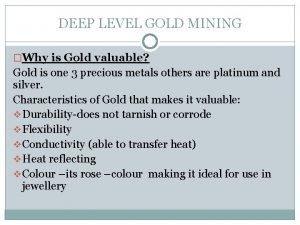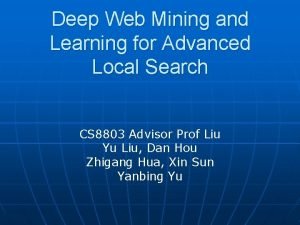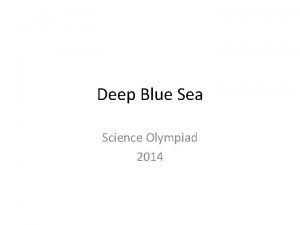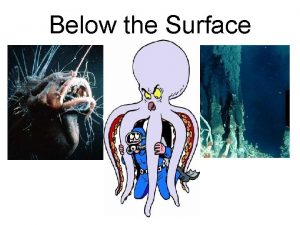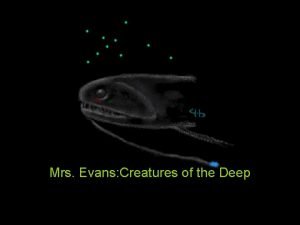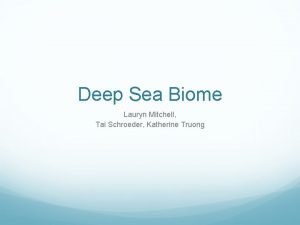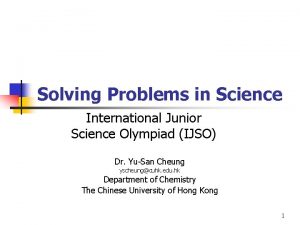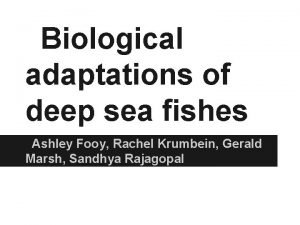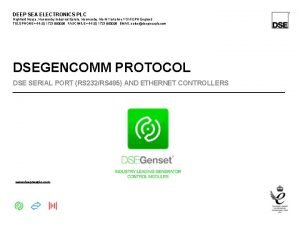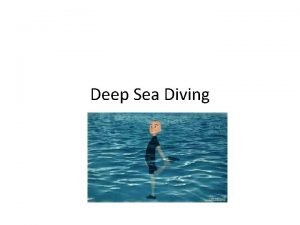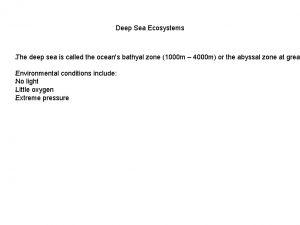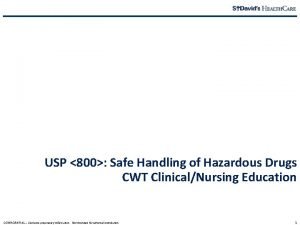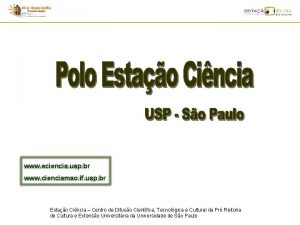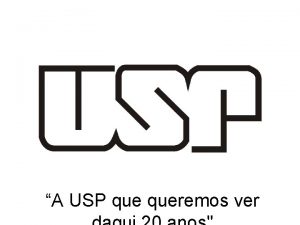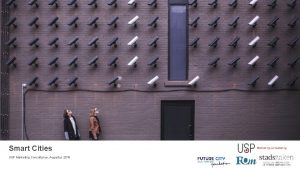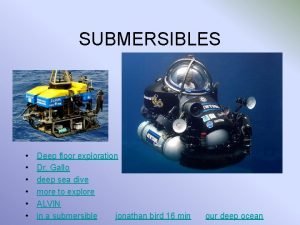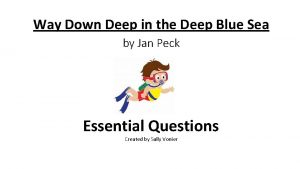USP SEMINAR ON DEEP SEA MINING 28042016 The



















- Slides: 19

USP SEMINAR ON DEEP SEA MINING 28/04/2016 The general legal framework Pierre-Jean Bordahandy 1

Presentation Overview Presentation of Deep Sea Mining? (The minerals, the rationale). The Law of the Sea Background Rights to DSM in Areas Beyond National Jursidiction (ABNJ) Quick overview of the Legal Framework Quick Historical Background Quick overview of UNCLOS Part XI & the 1994 Agreement regime Rights to DSM in the extended Continental Shelf Right to DSM in the EEZ / CS The UNCLOS duties for States in relation to Deep Sea Mining In their zone of jurisdiction EEZ – CS / in The Area State Duties / State Liability Other relevant Norms 2

Cobalt Rich Crust Seafloor Massive Sulphides Manganese Nodules 3

DSM – The Minerals and Rationale Deep Sea Mining: The minerals. These minerals found in three types of deposits: Cobalt Rich Crust, rich in Cobalt, Nickel, Manganese, Rare Earth elements, Platinum. Difficult to mine according to the mining cies. Massive Sulphites, and Coper, Gold, Silver, and Zinc. Easier to mine. Manganese Nodules rich in Cobalt, Nickel, Coper, Rare Earth Elements. Easier to mine than the Cobalt Rich Crust Deep Sea Mining: The rationale. Concerns over shortage of these minerals metals on land location of these minerals raise many legal, political, techn, and 4 environmental issues.

DSM LOCATION Internal Waters Baseline Territorial Sea 12 Contiguous Zone Exclusive 12 Economic Zone 188 High Seas Max 350 or 100 beyond 2, 500 m Low Water Continental Shelf

The Area 6

DSM – In ABNJ – The Area UNCLOS PART XI Creation of ‘The Area’ (the Sea-Bed beyond national jurisdiction). Proposed Criteria of exploitability, res communis, res nullius Resources of the Area for the benefit of mankind as a whole. A. Pardo Creation of the International Sea-Bed Authority ('the ISA') Regulate the ‘prospecting’, ‘exploration’ and ‘exploitation’ of DSM (Mining Code). ISA must authorise State Parties or sponsored by State Parties to mine in the Area (State responsibility for contractor). Creation of ‘the Enterprise’ a parallel system of exploitation for the Area, recognising that developing States will enjoy special access rights to reserved (and already prospected) zones within the Area. Part XI of UNCLOS provides developing States with a practical and realistic means of participating in DSM mining. 7

History of UNCLOS Deep Sea Mining framework 1969 – UN Sea Bed Committee - UN General Assembly (1 st Committee – Political) G 77 secured majority for the adoption of Resolution 2574, Resources in the Area Beyond National Jurisdiction are Common Heritage, Effect of UN General Assembly Resolutions in Public international Law: Quasi legislative effect, but not binding upon those who voted against. However, States that have voted in favour might be considered bound by it on the basis of opinio juris creating therefore a rule of Customary International Law. 1970 – UN General Assembly Resolution 2749 adopted by 108 votes. Common Heritage, No individual Claim, Mining to be regulated by UN body UNCLOS 1982 – Adoption of Part XI – Opposition of developed Countries Adoption of ‘Pioneer Investor Rules’ – To try to get US, UK to sign UNCLOS Developed States tried to bypass Part XI by developping domestic / bilateral legislation. « The Reciprocating States Regime » Prepcom established by the of ‘Pioneer Investor Rules’ passed a resolution under the influence of the G 77 to oppose the « reciprocating State Regime » 1994 Prepcom managed to salvage UNCLOS III - Adoption of the 1994 Implementation of Part XI agreement 8

History of UNCLOS Deep Sea Mining framework The regime of UNCLOS Part XI & the 1994 Implementation agreement. UNCLOC art 134(2). Regime governs all activities connected with Exploration and exploitation of mineral resources in the Area. UNCLOS Art 1: the Area is defined as ‘the Sea-Bed and Ocean Floor and subsoil thereof beyond national jurisdiction. The Area itself & its mineral resources (Art 133) are the common heritage of mankind. (Not susceptible of unilateral appropriation). Rights in the Area can only be obtained in accordance with the provision of UNCLOS Part XI and the 1994 IA. (With ISA autorisation). All activity in the area (conducted by the authority itself through the Enterprise or by commercial operators) are to be acrried out for the benefit of mankind as a whole taking into consideration the interest of develping countries (UNCLOS Art 140). ISA has no authority for activities not connected. (Fishing, cables, etc). The superjacent waters and air space remain high seas. 9

History of UNCLOS Deep Sea Mining framework The regime of UNCLOS Part XI & the 1994 Implementation agreement. The institution / structure created by UNCLOS: The International Sea Bed Authority (ISA) www. isa. org. jm The Assembly: composed of UNCLOS members (1 vote per member). The Council: Governing body of the Enterprise - Art 162 gives a list of its tasks and attributions. 36 Members elected by the assembly (see Art 161 - detailed provisions about the composition / representation of the council). The Secretariat: Admin of the Authority. Mr. Satya N. Nandan (Fiji) 1 st Sec. legal affairs, and environment management and monitoring. The legal and Technical Commission: 25 members elected for 5 years on the basis of their expertise relating to ocean mining and related fields. The Economic Planning Commisssion: Art 163 & 164 replaced by IA 1994 by function of ‘economic assistance’ to be performed by the above committee The finance Committee: created by IA 1994 – 15 members elected for 5 years, taking into account geographical distribution, financial / budgetary expertise, responsible for budget, members contributions & financial rules The Enterprise: Radical change by IA 1994. No longer independent operator, supervised by secretariat until financial autonomy, must engage in joint ventures , very modest functions of the Entreprise with Sea-Bed mining conspicuously not 10 made a priority.

DSM – In the Extended CS: 200 -350 NM UNCLOS Article 82 - Payments and contributions with respect to the exploitation of the continental shelf beyond 200 nautical miles 1. The coastal State shall make payments or contributions in kind in respect of the exploitation of the non-living resources of the continental shelf beyond 200 nautical miles from the baselines from which the breadth of the territorial sea is measured. 2. The payments and contributions shall be made annually with respect to all production at a site after the first five years of production at that site. For the sixth year, the rate of payment or contribution shall be 1 per cent of the value or volume of production at the site. The rate shall increase by 1 per cent for each subsequent year until the twelfth year and shall remain at 7 per cent thereafter. Production does not include resources used in connection with exploitation. 3. A developing State which is a net importer of a mineral resource produced from its continental shelf is exempt from making such payments or contributions in respect of that mineral resource. 4. The payments or contributions shall be made through the Authority, which shall distribute them to States Parties to this Convention, on the basis of equitable sharing criteria, taking into account the interests and needs of developing States, 11 particularly the least developed and the land-locked among them.

DSM – In the CS: up to 200 NM 12

DSM – In the CS: up to 200 NM SOPAC / Japan Co-operative survey 1985 -2005 PNG, Solomon Islands, Vanuatu, Fiji, Tonga, Samoa, Niue, Cook Islands, Kiribati, Tuvalu, FSM, Marshall Islands Mineral potential evaluation, resource estimates, environmental survey 13

DSM – In the CS: up to 200 NM Rights of the Coastal state within its EEZ / CS Articles 56 and 77: Coastal States sovereign rights (exclusive) to exploit, develop, manage own natural resources. Article 81: Coastal States exclusive right to authorise and regulate drilling on the continental shelf, for all purposes. Articles 60 & 80: Coastal States exclusive jurisdiction to construct / authorise / regulate artificial islands, installations and structures for economic purposes in the EEZ or on the CS. Article 61: States have obligation to its citizens for the proper use and exploitation of its resources; and to protect and preserve marine resources and marine scientific research. (No requirement to conserve or to manage sustainably mineral resources like with fisheries) 14

DSM – State Duties of the Coastal state within its EEZ / CS Coastal States duty to protect the marine environment within its EEZ (Art 56(2)(b)(iii)), prevent pollution from Sea-Bed activities (Art 208), pollution by dumping (Art 210(5)) and incidental pollution from vessels (Art 211(5) and (6)). States’ general obligation to protect and preserve the marine environment (Art 192). States have the sovereign right to exploit their natural resources pursuant to their environmental policies and in accordance with their duty to protect and preserve the marine environment (Art 193). States shall take all appropriate measures necessary to ensure that activities under their jurisdiction or control are so conducted as not to cause damage by pollution to other States and their environment, and to protect and preserve rare or fragile ecosystems and marine life habitats (Art 194). State duty to minimize pollution and accidents (Art 194(3)); State duty not to transfer damage or hazards or transform one type of pollution into another (Art 195); State Duty to monitor risks or effects of pollution (Art 204). 15

DSM – State Duties How can Coastal States achieve the above? Articles 208, 209, 210 specifically require coastal states to adopt laws and regulations to prevent, reduce and control pollution of the marine environment arising from Sea-Bed activities subject to their jurisdiction. These laws are to be no less effective than international rules, standards and recommended practices and procedures. Article 214 requires enforcement of those laws - by measures which are reasonably appropriate for securing compliance by persons under that State’s jurisdiction. Articles 204 -206: direct obligation to monitor risks / impact to the marine environment, arising from their activities; and to conduct an environmental impact assessment (and to publish it), where States have reasonable grounds for believing that planned activities under their jurisdiction may 16 cause substantial pollution or significant harmful changes to

DSM – State Duties Article 235: States are responsible for the fulfilment of their obligations concerning the protection and preservation of the marine environment; and shall be liable in accordance with international law States shall ensure recourse is available in their legal system for prompt and adequate compensation in respect of damage caused by pollution of the marine environment by persons under their jurisdiction. Within the Area Article 139: ‘responsibility to ensure…’ that activities under its control comply with UNCLOS. Damage caused by the failure of a State to carry out its responsibilities shall entail liability. A State Party shall not however be liable for damage caused by any failure to comply with UNCLOS by a person whom it has sponsored, if 17 the State Party has taken all necessary and appropriate

DSM – Other Relevant Norms Other legal framework relevant for Deep Sea Mining Noumea Convention - Convention for the Protection of Natural Resources and the Environment of the South Pacific Region. Convention on Biological Diversity. UNEP 1992 Rio Declaration on the Environment and Development IMO Conv. (SOLAS, Load Lines, ISM, MARPOL, etc) Maybe… Some Standards: EITI: Global standard that promotes revenue transparency. IMMS Code 2001: For Environmental Management of Marine Mining Madang Guidelines & SPC-EU / SOPAC project Pacific Plan 18

VINAKA THANK YOU 19
 Deep sea mining
Deep sea mining Mining complex types of data
Mining complex types of data Difference between strip mining and open pit mining
Difference between strip mining and open pit mining Difference between text mining and web mining
Difference between text mining and web mining Strip mining vs open pit mining
Strip mining vs open pit mining Multimedia data mining
Multimedia data mining Strip mining vs open pit mining
Strip mining vs open pit mining Web mining
Web mining O the deep deep love of jesus
O the deep deep love of jesus Deep asleep deep asleep it lies
Deep asleep deep asleep it lies Deep forest: towards an alternative to deep neural networks
Deep forest: towards an alternative to deep neural networks Science olympiad deep blue sea
Science olympiad deep blue sea Deep ocean abiotic factors
Deep ocean abiotic factors Tripod fish
Tripod fish Deep sea abiotic factors
Deep sea abiotic factors International junior science olympiad 2020
International junior science olympiad 2020 Pelican eel adaptations
Pelican eel adaptations Deep sea electronics hunmanby
Deep sea electronics hunmanby Led soldiers across hellespont into anatolia goals
Led soldiers across hellespont into anatolia goals Sea cave
Sea cave
